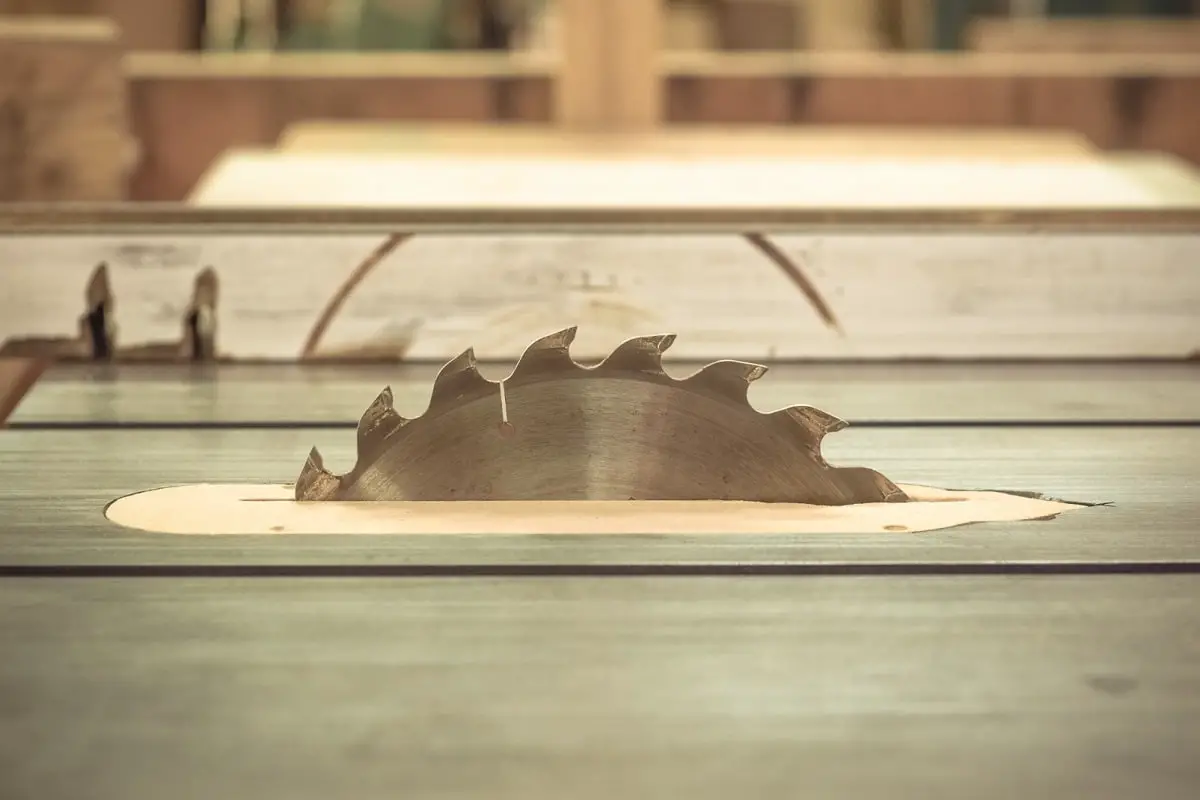Table saws are a production woodworker’s best friend. While most of their work can be done with a handheld saw, larger jobs require more power and precision.
Table saws can easily and quickly cut through large pieces of wood with minimal effort, making this tool a valuable addition to your workshop.
In this article we cover all the basics about table saws and how they can be used safely.
What Is a Table Saw?
A table saw features a circular blade mounted underneath the surface of a table, and a small part of the blade protrudes above it. This part is used to saw through wood. You have to guide the piece of wood you want to cut towards the blade.
Markings and measurements on the table allow you to cut the wood at different angles with greater precision. An arbor is used to hold the saw in place, and it also enables you to modify the cutting angles or depths.
A table saw brings about great benefits in the woodworking industry, and it’s an essential tool to have. Plus, it also takes the load off your hands, as you don’t have to hold the saw for a long time. You can also find portable table saws that can be transported from one location to another but having one in your workshop or garage is quite handy.

Are Table Saws Different Than Scroll Saws or Miter Saws?
Table saws are similar in design to other circular saws, such as scroll and miter saws. A miter saw is also connected to a table or a frame and is used for more precise cutting work.
A miter saw (aka chop saw) is more portable than a table saw, and it allows you to make accurate cuts by lowering the blade down to piece of wood you want to cut.
A scroll saw is similar to a band saw but has a longer and narrower blade. It’s more suitable for detailing and curved pattern cuts. Table saws are used to make straight cuts.
Scroll saws are available in electric and pedal-powered variants, which is another major difference between them and a table saw.
What Is a Mini Table Saw?
Although a table saw is highly useful for your workshop, the chances are that you might not have sufficient space to accommodate it. However, this doesn’t mean you have to do without it. If you have space constraints, you can opt for a mini table saw, a smaller version of the table saw but does the job well.
Mini table saws are compact and take up less space. They’re much more economical than a full-size table saw, making them a valuable addition for DIY enthusiasts. Also, they can be easily assembled and transported from job to job.
However, a mini table saw doesn’t provide you with the same power as a traditional table saw, and it also doesn’t come with the full features that they provide.
Are Table Saws Dangerous?
If you compare them to other types of saws, table saws are considered much more harmful and dangerous. The reason for this is the sharp blade that protrudes from it. If you’re not careful, you can accidentally strike your hand against the blade, which can be quite catastrophic.
Injuries caused by table saws cause thousands of deaths every year, which is why most people hesitate to use them. However, you can protect yourself from any deadly injuries or accidents by using proper safety procedures, such as using cut-resistant gloves and installing safety switches for your table saws.
Table Saw Safety Tips
If you think about it, every power tool can be dangerous for you if you don’t use it properly or don’t equip yourself with the proper safety gear. Therefore, you can employ certain safety tips to ensure the safe operation of your table saws. As mentioned above, installing a safety switch is one of the best ways to prevent any accidents.
Here are some table saw safety tips that you should always follow:
- Clear your table saw of any raw materials, tools, or any other equipment used in the woodworking process. Once you turn the saw on, it shouldn’t collide with anything else.
- Clear a safe space of 2 feet around the table so that you have enough space to maneuver the wood pieces properly.
- Check the type of blade that you’re using for the job. Make sure that it’s suitable for the purpose you’re using it for. Also, check for the tightness of the nut that holds the blade.
- Inspect the safety elements of your table saw and check that each is working properly. This will help you stay safe, even if the saw malfunctions.
- Keep clear of the electrical cord so that it doesn’t wrap around your feet or cause you to trip.
- Use safety gear like safety goggles, face shields, cut-resistant gloves, and other suitable equipment. This will protect you from wood chippings or any slip-ups you might make.
In a nutshell, table saws are a wonderful power tool to use for cutting wood with greater accuracy and precision. Not only are they useful for cutting all types and lengths of wood, but they also ensure convenience and utility. They can be used for crosscuts, miter cuts, ripping, rabbeting, and many other applications.
We hope this article helps you understand what a table saw is and how you can safely use it for all your woodworking and DIY projects. All you need to do is go out, choose a suitable table saw, clear some space for it, and install it in your workshop. Then, ensure you adhere to safety procedures while using them for your projects.

